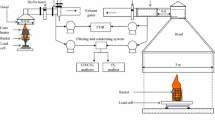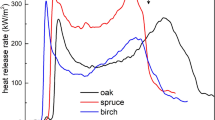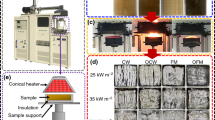Abstract
This paper deals with the fire reaction as well as the gas and aerosol production of Cross-Laminated Timber (CLT) submitted to fire in oxygen-depleted environments. A Controlled-Atmosphere Cone Calorimeter (CACC) coupled to a Fourier Transform Infrared (FTIR) spectroscopy and an Electrical Low Pressure Impactor (ELPI) was used for this purpose. This combination enabled simultaneous assessments of Mass Loss Rate (MLR), evolved gases (qualitatively and quantitatively) and aerosols (size distribution and concentration) in the smoke. Several oxygen levels (21, 18, 15 and 10% O2) were studied at an external heat flux of 50 and 20 kW/m2. The combination of these two parameters allowed the response of CLT to be classified according to different fire scenarios. Indeed, an oxygen decrease shifted the combustion towards incompleteness or even prevented combustion. The production of carbon monoxide and methane was significantly promoted as well as acetaldehyde and ethene in some cases. The aerosol size distribution was slightly affected by oxygen depletion. Furthermore, decreasing the heat flux greatly reduced the decomposition rate but also promoted the production of unburnt gases.
















Similar content being viewed by others
References
Hall JJ, Harwood B (1995) Smoke or burns - Which is deadlier ? NFPA J 89(1):38–43
Guillaume E, Effets du feu sur les personnes, p 163
ISO 13571 (2012) Life-threatening components of fire—Guidelines for the estimation of time to compromised tenability in fires
ISO 5660–1:2015 (2015) Reaction-to-fire tests—Heat release, smoke production and mass loss rate—Part 1: heat release rate (cone calorimeter method) and smoke production rate (dynamic measurement)
Werrel M, Deubel JH, Krüger S, Hofmann A, Krause U (2014) The calculation of the heat release rate by oxygen consumption in a controlled-atmosphere cone calorimeter: heat release rate in a controlled-atmosphere cone calorimeter. Fire Mater 385(2):204–226. https://doi.org/10.1002/fam.2175
Marquis D, Guillaume E, Lesenechal D (2013) Accuracy (Trueness and Precision) of cone calorimeter tests with and without a vitiated air enclosure. Procedia Eng 62:103–119. https://doi.org/10.1016/j.proeng.2013.08.048
Mulholland G, Janssens M, Yusa S, Twilley W, Babrauskas V (1991) The effect of oxygen concentration on Co and smoke produced by flames. Fire Saf Sci 3:585–594. https://doi.org/10.3801/IAFSS.FSS.3-585
Nelson GL (1995) Fire and Polymers II: Materials and Tests for Hazard Prevention, in ACS Symposium Series. American Chemical Society, Washington, DC
Marquis D, Guillaume E, Camillo A (2014) Effects of oxygen availability on the combustion behaviour of materials in a controlled atmosphere cone calorimeter. Fire Saf Sci 11:138–151. https://doi.org/10.3801/IAFSS.FSS.11-138
Sarah C (2019) An instrumented controlled-atmosphere cone calorimeter to characterize electrical cable behavior in depleted fires, p 249
Etienne M, Evaluation du risque d’inflammation de gaz imbrûlés au cours d’un incendie en milieu sous-ventilé, p 283
Marquis DM, Guillaume E, Effects of under-ventilated conditions on the reaction-to-fire of a polyisocyanurate foam, p 13
Hermouet F, Développement d’une approche innovante de modélisation de la cinétique de décomposition thermique des matériaux solides en espaces confinés sous-ventilés. sApplication aux incendies en tunnel, p 265
Swann JD, Ding Y, McKinnon MB, Stoliarov SI (2017) Controlled atmosphere pyrolysis apparatus II (CAPA II): a new tool for analysis of pyrolysis of charring and intumescent polymers. Fire Saf J 91:130–139. https://doi.org/10.1016/j.firesaf.2017.03.038
Marquis DM, Guillaume E, Camillo A, Rogaume T, Usage of controlled-atmosphere cone calorimeter to provide input data for toxicity modelling, p 13
Mustafa BG, Toxic species and particulate emissions from wood and pool fires, p 342
ISO/TS 5660–5:2020 (2020) Reaction-to-fire tests—Heat release, smoke production and mass loss rate—Part 5: heat release rate (cone calorimeter method) and smoke production rate (dynamic measurement) under reduced oxygen atmospheres
Tewarson A, Jiang F, Morikawa T (1993) Ventilation-controlled combustion of polymers. Combust Flame 95(1–2):151–169. https://doi.org/10.1016/0010-2180(93)90058-B
Brohez S, Marlair G, Delvosalle C (2008) The effect of oxygen concentration on CO and soot yields in fires. Fire Mater 32(3):141–158. https://doi.org/10.1002/fam.960
EN 13238:2010 (2010) Reaction to fire tests for building products - Conditioning procedures and general rules for selection of substrates
Alarifi A, Andrews G, Witty L, Phylaktou H (2013) Ignition and toxicity of selected aircraft interior materials using the cone calorimeter and FTIR analysis, Proceedings of the InterFlam 2013. InterScience Communications: London, UK. 1: 37–48, ISBN: 978-0-9556548-9-3
Irshad A, Andrews G, Phylaktou H, Gibbs B (2019) International seminar on fire and explosion hazards (9; 2019; Saint Petersburg, Russia). Develop Control Atmos Cone Calorim Simulate Compart Fires. https://doi.org/10.18720/SPBPU/2/K19-90
Ngohang FE, Combination of mass loss cone, Fourier transform infrared spectroscopy and electrical low pressure impactor to extend fire behaviour characterization of materials, p 155
ISO 19706:2011 (2011) Guidelines for assessing the fire threat to people
Stec AA, Hull R (2010) Fire Toxicity. Woodhead Publishing, Sawston
Friquin KL (2011) Material properties and external factors influencing the charring rate of solid wood and glue-laminated timber. Fire Mater 325(5):303–327. https://doi.org/10.1002/fam.1055
Di Blasi C, Hernandez HG, Santoro A (2000) Radiative Pyrolysis of Single Moist Wood Particles. American Chemical Society, Washington, DC
Quintiere JG, Rhodes B (1994) Fire growth models for materials, National Institute of Standards and Technology
Sullivan AL, Ball R (2012) Thermal decomposition and combustion chemistry of cellulosic biomass. Atmos Environ 47:133–141. https://doi.org/10.1016/j.atmosenv.2011.11.022
Cuevas J, Torero JL, Maluk C (2021) Flame extinction and burning behaviour of timber under varied oxygen concentrations. Fire Saf J 120:103087. https://doi.org/10.1016/j.firesaf.2020.103087
Mikkola E (1991) Charring of wood based materials. Fire Saf Sci 3:547–556. https://doi.org/10.3801/IAFSS.FSS.3-547
Collard F-X, Blin J (2014) A review on pyrolysis of biomass constituents: mechanisms and composition of the products obtained from the conversion of cellulose, hemicelluloses and lignin. Renew Sustain Energy Rev 38:594–608. https://doi.org/10.1016/j.rser.2014.06.013
Laaongnaun S, Patumsawad S (2022) Particulate matter characterization of the combustion emissions from agricultural waste products. Heliyon 8(8):e10392. https://doi.org/10.1016/j.heliyon.2022.e10392
Hosseini S et al (2010) Particle size distributions from laboratory-scale biomass fires using fast response instruments. Atmos Chem Phys 10(16):8065–8076
Lighty JS, Veranth JM, Sarofim AF (2000) Combustion aerosols: factors governing their size and composition and implications to human health. J Air Waste Manag Assoc 50(9):1565–1618. https://doi.org/10.1080/10473289.2000.10464197
Hertzberg T, Blomqvist P (2003) Particles from fires: a screening of common materials found in buildings. Fire Mater 27(6):295–314. https://doi.org/10.1002/fam.837
Nussbaumer T, Czasch C, Klippel N, Johansson L, Tullin C 9, Particulate Emissions from Biomass Combustion in IEA Countries. p 40
Hurley MJ et al (2016) SFPE Handbook of Fire Protection Engineering. Springer, New York. https://doi.org/10.1007/978-1-4939-2565-0
Delichatsios MA (2005) Piloted ignition times, critical heat fluxes and mass loss rates at reduced oxygen atmospheres. Fire Saf J 40(3):197–212. https://doi.org/10.1016/j.firesaf.2004.11.005
Ohlemiller TJ, Kashiwagi T, Werner K (1987) Wood gasification at fire level heat fluxes. Combust Flame 69(2):155–170. https://doi.org/10.1016/0010-2180(87)90028-9
Di Blasi C (2004) The burning of plastics. In: Troitzsch J (ed) Plastics Flammability Handbook, Principles Regulation Testing and Approval. Carl Hanser Verlag GmbH & Co KG, München, pp 47–132
Kashiwagi T (1994) Polymer combustion and flammability—Role of the condensed phase. Symp (Int) Combust 25(1):1423–1437. https://doi.org/10.1016/S0082-0784(06)80786-1
Shen J, Wang X-S, Garcia-Perez M, Mourant D, Rhodes MJ, Li C-Z (2009) Effects of particle size on the fast pyrolysis of oil mallee woody biomass. Fuel 88(10):1810–1817. https://doi.org/10.1016/j.fuel.2009.05.001
Funding
Centre Scientifique et Technique du Bâtiment.
Author information
Authors and Affiliations
Corresponding authors
Additional information
Publisher's Note
Springer Nature remains neutral with regard to jurisdictional claims in published maps and institutional affiliations.
Rights and permissions
Springer Nature or its licensor (e.g. a society or other partner) holds exclusive rights to this article under a publishing agreement with the author(s) or other rightsholder(s); author self-archiving of the accepted manuscript version of this article is solely governed by the terms of such publishing agreement and applicable law.
About this article
Cite this article
Lamandé, A., Marchetti, V., Bourbigot, S. et al. Effects of Oxygen Concentration on the Reaction to Fire of Cross-Laminated Timber in a Controlled-Atmosphere Cone Calorimeter. Fire Technol (2024). https://doi.org/10.1007/s10694-023-01518-0
Received:
Accepted:
Published:
DOI: https://doi.org/10.1007/s10694-023-01518-0




